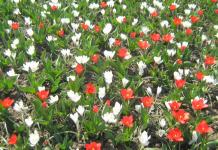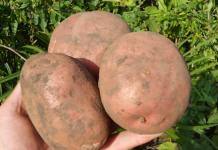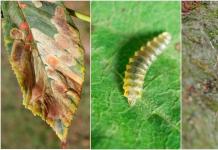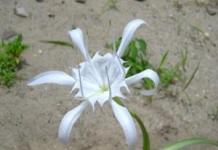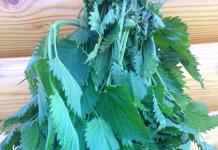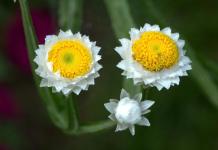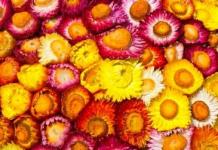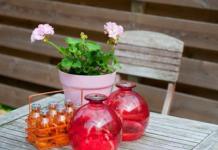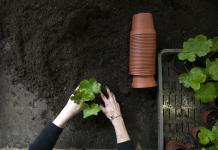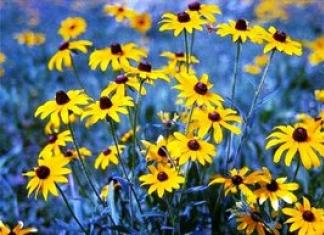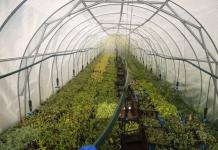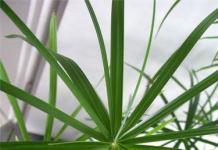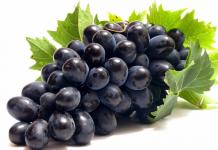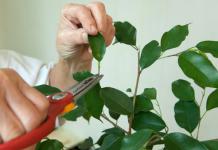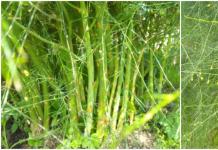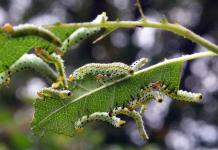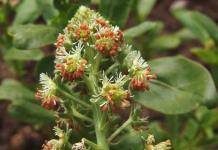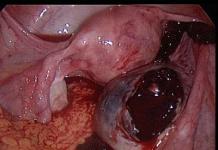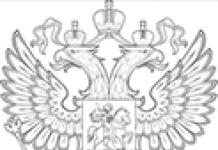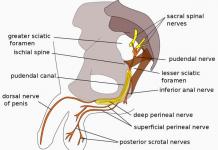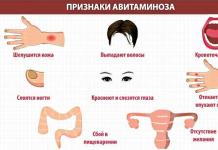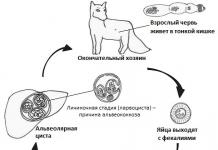Deciduous tree species are susceptible to bacterial, viral and fungal diseases. Fungal diseases are the most common cause of dark spots.
Chestnut mottling: yellow or ocher spots on the leaves
In summer, large yellow or ocher spots appear on both sides of the chestnut leaves, surrounded by a thin rim and often merging with each other.
Over time, in the necrotic part of the leaf blade, point fruiting bodies are formed - pycnidia, the leaves fall prematurely.
The causative agent of the disease is the fungus Phyllosticta castaneae Ell. et Ev. Another fungus is quite common - Cylindrosporium castanicola (Desm.) Bert., Which causes brown spotting of chestnuts in the form of reddish-brown small and angular spots, sometimes surrounded by a yellowish rim. In both cases, the infection persists in the fallen affected leaves.
Control measures for chestnut spotting
- collection and destruction of fallen leaves,
- spraying trees during bud break and leaf regrowth with 1% Bordeaux mixture or its substitutes
- ("Abiga-Peak", "Stroby", "Angle," Pure color ").
Miner chestnut moth: well-defined, rounded brown spots on leaves
Injuries from the chestnut miner moth (Cameraria ohridella) are more common in urban environments than fungal infections. It is worth spending one summer on a tree of a mining moth colony, most of the crown will no longer be saved.
 In the photo: a leaf damaged by a chestnut mining moth; caterpillar of miner chestnut moth; adult chestnut miner
In the photo: a leaf damaged by a chestnut mining moth; caterpillar of miner chestnut moth; adult chestnut miner
An adult moth looks like a butterfly, reaching the order of a centimeter at its full wingspan. One individual is capable of laying about 50 eggs in one clutch. Larvae and caterpillars cause damage to the leaves.

Control measures for chestnut moth
- Treatment with an insecticide of systemic action, for example, "Aktara".
- Collection and destruction of fallen leaves.
- In spring - shelter of young seedlings with non-woven material, scaring away butterflies with water jets.
- For monitoring, it is recommended to use pheromone traps (1 trap per 10 trees). They are hung up before the beginning of the flowering of chestnuts in places with an increased likelihood of the appearance of insect pests at a height of 1.5-2 m from the ground.
- Inspect traps at least once a week, replacing dusty or insect-covered adhesive pad. 4-6 weeks after installation, the trap should be replaced with a new one. In case of mass infection, it is recommended to hang 2 traps on the tree from different sides of the crown and at different heights.
- As a preventive measure, it is necessary to maintain a favorable microclimate in the garden and natural balance. About 20 bird species have been counted to eat the chestnut moth, including the titmouse and blue tit. From insects with larvae, ants, ladybugs, wasps, spiders quickly deal with them.
VIDEO instruction on the treatment of chestnuts from chestnut moth from Evgeny Sapunov, owner of the private botanical garden Dragon Garden and landscape designer
Every gardener observed brown, white, black spots on his garden pets at least once. Leaf spot not only spoils the appearance of plants, but also deprives the lion's share of the harvest. The spots can have different shapes and colors. They appear on leaves of any age, but they do the most harm to young plants. There are diseases that affect not only leaves, but also fruits. Aggressively manifested spotting leads to drying out of leaves, their premature shedding and, as a consequence, to disruption of the physiological processes of the plant, its exhaustion and death.
To figure out how to deal with this "colorful splendor" it is necessary to identify the disease, to deal with pathogens and ways of spreading. Leaf spot can be caused by fungi, bacteria and viruses. But most often there are spots of fungal origin, which affect a huge number of garden and indoor crops.
Initially, white spotting appears as many small, rounded brown spots on the foliage. Then these spots grow, the middle brightens, and the edges acquire a brown tint. In wet weather, spots can rot, and in hot weather, they can dry out and fall out, leaving holes on the sheets.
From the foliage, the disease spreads throughout the plant. Affected shoots are first covered with brown spots, and then die off. The fruits become small, tasteless or completely unusable.
Affected crops
Berry crops (strawberries, currants, gooseberries, raspberries) are severely affected by white spot. Black currants are more likely to suffer from this disease than red and white ones. On gooseberries, white spot "covers" the entire bush. Affected leaves dry out and fall off. Berries covered with a white bloom lose their taste, and rot during high humidity.
No less deplorable "picture" with the defeat of the pear. The first signs of the disease appear in the form of grayish spots as early as May. The ripening fruits, as a rule, cover the same "marks".
Tomatoes can also be affected by white spot. Initially, brownish spots appear on the lower leaves. Then they increase in size and spread along the upper stems and petioles. As a rule, the fruits remain intact.
Causative agents of the disease
All crops (except for gooseberries) are affected by the fungus Mycosphaerella fragariae Lind. And the disease is called septoria. The pathogen actively multiplies during the period when rains alternate with sunny days (the fungus develops faster in the light). The optimum temperature for its distribution is 20-25 ° C. But +3 and +35 are not a hindrance for him.

On the affected areas of the leaf, sclerotia with spores are formed, which germinate the next year under favorable conditions.
The source of the spread of septoria is primarily diseased plants and unharvested plant debris.
Gooseberry is affected by the fungus Phylosticta Grossulariae Sacc. Its peculiarity is that it "captures" only diseased and old shrubs. Moreover, if the disease manifests itself this season, it is not necessary that it will appear in the next.
Drugs against septoria
Most often, Bordeaux fluid is used in the fight against septoria. During the period when shrubs and trees are still without foliage, they are treated with a 4% solution. For growing leaves, it is permissible to use a 1% solution. To get rid of the white spot of the strawberry beds, three sprays are carried out with a 1% solution of the Bordeaux mixture:
- first - as soon as the buds begin to appear;
- the second - after 10 days;
- the third is after the harvest.
Also, in the fight against white spot, the preparations Horus (consumption 0.7 kg / ha - before flowering and 0.4 kg / ha - after flowering) and Switch (consumption 1 kg / ha) are effective.
It is important to remember that strawberries cannot be processed during the fruiting period. If such a forced measure is required, then the berries cannot be eaten after spraying.
Fight without chemicals
Unfortunately, even chemical preparations are not always effective against the fungus Mycosphaerella fragariae Lind. But if you follow preventive measures, then the disease can be defeated.
Since the source of infection is infected parts of plants, they must be mercilessly parted with. If you notice suspicious spots on the leaves of shrubs or strawberries, they must be removed immediately.
If the entire strawberry bed is affected, then you need to choose young, undamaged sockets and transplant them to a new place as soon as possible. Dig up an old bed and plant crops that are not susceptible to this disease.

Tomato seedlings most often suffer from white spot, therefore, when purchasing it, you need to discard specimens even with small spots. It is better, of course, to grow seedlings on your own, using seeds that are not infected with fungal diseases. If sick specimens are found in the garden, they are removed and burned. After harvest, they also come with the rest of the tops. In the place where the tomatoes grew, next year only crops that do not suffer from fungal diseases can be planted.
When growing tomatoes in a greenhouse, you need to monitor the humidity: ventilate more often and minimize watering.
Imagine how insulting the fungus is! I woke up in the spring, hoping that it would eat and multiply, and then once - and there is no "house"! The poor man can only "fall asleep" and wait for the owner of the site to lose vigilance.
How to deal with the harvest
At least once each of us ate a “spotted” pear and a “wrapped” gooseberry. They, of course, did not poison anyone. But their taste is much worse than that of healthy fruits. In addition, the amount of vitamins, organic acids and biologically active compounds is reduced in berries from an infected plant. That is, they become not only not tasty, but also useless. So the question arises - why are they then there?
Brown spot
Brown spot appears in May - early June with light olive spots, which are barely noticeable. Then they turn yellow or brown, and a gray or greenish-brown bloom appears on the underside of the leaf, in which spores ripen, ready to spread over a long distance at the slightest breeze. Brown spot only on some crops extends to shoots and fruits. But due to the fact that the affected leaves die off, impairing the photosynthesis of the entire plant, it begins to lag behind in growth and can no longer fully bear fruit.
Such signs can be found in various horticultural crops. Moreover, different cultures are affected by different types of fungus. But since they all have the same characteristics and similar methods of struggle, they are often combined under the same name "brown spot".
The causative agent and its "victims"
Cladosporium fulvum is a fungus that most commonly affects tomatoes and cucumbers. Moreover, not only leaves are damaged on cucumbers, but also tops and fruits. Sometimes found on peonies. In the first stage, cladosporium appears as light, irregular spots on the outside of the leaf. Then a brown or grayish bloom appears on the underside. The leaves begin to dry and curl up, but do not fall off. The disease most often develops in greenhouse conditions, when the temperature in the greenhouse is kept at the level of 20-25 ° C, and the humidity is 90%.

The Marssonina fungus affects strawberries, nuts, poplars, and birches. If on ornamental plants only the appearance suffers from marsoniasis, then “settling” on nuts, it affects leaves, shoots, flowers and fruits. This disease is a real scourge that can destroy the harvest of large plantations. This mushroom is no less dangerous for strawberries, since it affects the leaves so much that the plant simply dies. The main condition for the development of marsoniasis is very high humidity.
The Phyllosticta mushroom has taken a fancy to the foliage of raspberry, apple, pear, chestnut, mountain ash, elm and maple. Phyllostictosis can also occur on indoor plants (ficuses, ivy, palms). Because of this fungus, chestnuts remain leafless as early as July or early August. It appears on fruit crops as well as scab.
Preparations against brown spot
At the first signs of the disease on tomatoes and cucumbers, they are treated with the Barrier preparation (8 g per 10 l of water). The beds are sprayed again after 10 days. If such a drug is not available, you can use any copper-based product.
For strawberries infected with brown spot, Euparen or Gamair is suitable. They are sprayed with a garden bed before flowering and after harvesting. Horus, Ridomil, Ordan, Bravo are used as a preventive measure against marsoniasis.
To save the nut crop, trees are sprayed with a 3% solution of Bordeaux liquid before sap flow begins. Then, as the leaves begin to grow, they are treated twice with an interval of 10 days with a 1% solution.
Bordeaux mixture is also effective in the fight against phyllostictosis. She carries out 2-3 treatments per season.
Roses suffering from brown spot are treated 2-3 times per season with a 3% solution of copper sulfate or Cineb and Benlat preparations.
Folk remedies
With brown spot, you can try to cope with folk methods using the following recipes:
- Add 300 g of ash to 10 liters of water and boil. Water the plants with this broth every other day, alternating with a weak solution of potassium permanganate.
- Grind 0.5 kg of peeled garlic, mix with 10 liters of water, insist for a day and spray on diseased plants.
These funds can be used in the early stages of the disease or as a prophylaxis.
Preventive actions
In order not to meet with brown spot, you need to adhere to the following simple rules:
- choose resistant varieties;
- before sowing, soak the seeds in a fungicide solution;
- purchase only healthy planting material;
- ensure good air exchange (do not plant plants close, pick off the lower leaves of tomatoes, ventilate the greenhouse);
- avoid the accumulation of moisture on the leaves (water at the root and only with warm water in the morning);
- after harvesting, remove and burn tops, affected leaves and shoots;
- treat the greenhouse and garden tools with disinfectants;
- do not use fresh manure and compost (any pathogenic fungi actively develop in this environment).
Danger in fruits
Nuts rotted from Marsoniasis, of course, will not be eaten. And apples and pears, when they are affected by phyllostictosis, lose only their appearance and do not affect human health, so you can peel off the skin and eat the pulp. If there are enough unaffected fruits, the damaged ones can be fed to the bird.
In no case should you put stained fruits on the compost!
Dry spot
This disease harms not only foliage, but also fruits. In particularly favorable conditions, the disease can reduce the yield by 50%. Initially, dry spotting appears as dark spots of varying size on the leaves. Then the leaf begins to turn yellow and dry. On the affected fruits, black spots can be observed, under which rot is hidden.
Who is sick with dry spotting
Potatoes, tomato, pepper, cabbage - these are the favorite crops of this disease. Among fruit crops, dry spot causes the greatest harm to grapes. Apple trees can also be damaged.
The cause of the disease
Dry spot is caused by the fungus Alternaria solani. Hence the name of the disease - Alternaria.

The best conditions for this fungus are 26 ° C and high humidity. It spreads with the help of mycelium and conidia, which are carried through the air. Also, infection can occur through the soil and planting material. Diseased and weakened plants are mainly affected.
Preparations against Alternaria
Most fungicides are capable of suppressing the development of Alternaria. You can use Ridomil, Quadris, Poliram. If there is copper sulfate at hand, then for spraying, you can prepare a solution of 10 liters of water, 200 g of copper sulfate and soap shavings. If you need to spray plants at the fruiting stage, use biological preparations Trichodermin, Baktofit, Planriz. It is also used at the beginning of the growing season for preventive purposes.
The treatment is carried out with an interval of 10-14 days until the signs of the disease disappear completely.
Folk remedies
Dairy products have proven their effectiveness in the fight for the harvest more than once. In addition, whey and milk increase the immunity of plants, making them less susceptible to pathogenic fungi.
For spraying vegetable beds, prepare the following solutions:
- 15 drops of iodine and 0.5 liters of non-fat milk are added to 5 liters of water;
- 1 liter of whey is stirred in 10 liters of water.
The key to health in prevention
Dry spot is a fungal disease, therefore, the preventive measures described above will protect plants from Alternaria.

The only peculiarity is that this fungus attacks weak plants. Therefore, it is necessary to observe the agrotechnology of the crops grown as much as possible and monitor the fertility of the soil. It will not be superfluous in preventive measures to treat the beds with Immunocyte a couple of times a season. For this, 1 tab. crushed and dissolved in 2 liters of water.
Eating diseased fruits
Vegetables and fruits damaged by Alterniosis become unsuitable for human consumption. With a slight defeat, they lose their taste. For example, tomatoes may become tasteless or bitter. In more advanced cases, rot develops on the fruits, which is dangerous to health.
Black spot caused by fungi
Black spot is caused by several fungi that attack different plants. But the symptoms of the disease are not much different. Dark brown, almost black spots with a light middle or edge appear on the foliage. Damaged tissue swells. The disease invades stems and shoots. The plant weakens, sheds foliage, refuses to bloom, damaged shoots die off. Without treatment, the bush may die.
Ailing cultures
Black spot affects roses, lilacs, grapes. And if the appearance of ornamental shrubs suffers, then for grapes black spot is a serious threat.
Black, oval-shaped necrotic spots appear on young shoots in June. Over time, the affected areas are covered with cork, the leaves dry out and the shoots die. Annual wood is stained grayish. The berries on the affected bushes acquire a purple hue and an unpleasant aftertaste.
The causative agents of black spot
The fungus Phomopsis viticola infects grapes. The disease is called phomopsis or escoriasis. Spores of the fungus are carried by the wind, insects. Germinate in humid conditions. Plants get inside through lesions on the bark and stomata. Phomopsis weakens the bush, reduces its winter hardiness and after 5-6 years of uncontrolled development, the disease kills the bush.

Black spot of roses is caused by the fungus Marssonina rosae. The fungus hibernates in the soil and on plant debris. The fungus progresses during periods of low temperatures and frequent rains. Most often, bushes get sick, which suffer from a lack of potassium.
Drugs for treatment
The Phomopsis fungus spreads deep in the tissues, therefore contact fungicides are not suitable for fighting it. It is necessary to use systemic preparations aimed at long-term protection of plants.
If sick shoots were found on the bushes last summer, then the summer season should be started by spraying the grapes with DNOC or Nitrafen preparations. The procedure is performed as soon as the kidneys begin to swell. These are potent, toxic agents, so they cannot be applied to green leaves and fruits.
In the summer months, after prolonged rains or frequent growths, prophylactic spraying with Euparen, Kaptan, Maxim is carried out.
At the first signs of black spot on roses, the damaged foliage is removed, and the bushes begin to be sprayed with fungicides (Skor, Topaz, Fundazol). The treatment is carried out every 10 days until new spots stop appearing. It is recommended to shed the soil around the bushes with Fitosporin. This is a biological preparation that does not destroy beneficial microorganisms.
In the fall, before covering the roses, you need to free the bushes from the leaves and spray with a 3% solution of ferrous sulfate.
Folk ways of fighting
Decoctions of citrus fruits and herbs do not protect against black spot. Remedies from garlic and onions turned out to be more effective.
To do this, bring 40 g of husk to a boil, let it brew for 8 hours. The resulting solution is poured into soil around the roses.
To spray the bushes, prepare a solution of 1 ml of iodine and 400 ml of water.
Preventive measures
If you stick to just a few rules when growing grapes, you can minimize the likelihood of black spot infestation on the vine.

It is necessary to plant varieties resistant to fungal diseases. In the fall, before covering the bushes, it is imperative to remove shoots with any kind of damage and stains. In the spring, as early as possible, tie up the vines, preventing them from dropping to the ground. Feed the bushes regularly with fertilizers high in boron and zinc.
So that the roses do not hurt, they, too, in the spring, before the start of sap flow, remove all damaged shoots and carry out preventive spraying with iron sulfate. To keep the roses strong, they are fertilized with organic and mineral fertilizers. Moreover, be sure to alternate root and foliar feeding.
Danger of black spot
The insidiousness of escorosis is that this disease is considered "chronic". If many fungal diseases, if the plants are treated with drugs and kept in suitable conditions, "go away" during the season, then escoriasis (phomopsis) will have to be fought for more than one season, literally winning back every vine and bunch of grapes. Especially if you remember that this disease seriously affects the berries, making them unsuitable for human consumption.
Bacterial black spot
Spots on leaves caused by bacteria usually do not cause significant harm, but some of them can still harm the crop.
Affected crops
The most "malicious" bacteria infect tomatoes and peppers. First, watery spots 1-2 mm in size appear on tomatoes, then they "creep" along the leaf, stems and petioles. Over time, these spots turn yellow. On the fruits, at first, convex black spots with a watery border appear, and then rapidly decaying ulcers form in these places.
On pepper, the same watery spots are located along the veins and due to this they acquire an angular shape. Similar ulcers appear on the fruit.

The first signs of infection appear after 2-5 days, and after a couple of weeks, the disease can be found throughout the garden.
Causative agent of the disease
Tomato and pepper are attacked by the same bacterium - Xanthomonas vesicatoria. Most often, young immature plants and seedlings are sick. Infection occurs through the stomata and any mechanical damage. The bacterium begins to develop actively at an air humidity of 70% and a temperature of 25 ° C. At lower temperatures, its development slows down, but resumes with the return of favorable conditions.
The bacterium overwinters successfully on seeds and plant debris. Moreover, it was noticed that if the site is carefully removed and the bacteria of the food source are not left, then it dies after 5 days.
Preparations for protection
To exclude infection through diseased seed material, the seeds are soaked. For these purposes, a solution of trisodium phosphate is used (12 g per 100 ml of water). The seeds are soaked for 1 hour and then washed under running water. The drug Planriz kills not only bacteria retained on the membrane, but also intraseminal infections. The seeds are kept in it for 6 hours.
Unfortunately, it is almost impossible to save an infected plant. Therefore, in order to prevent infection, prophylactic spraying is carried out. Seedlings can be periodically irrigated with Fitosporin, Baktofit, Planriz. After planting in the ground, young plants are sprayed with Fitolavin.
Folk remedies
Those who do not use chemicals when growing vegetables can take a weak solution of potassium permanganate for dressing the seeds, in which the seeds are kept for 30 minutes. Or, soak the seeds in hot water at 60 ° C. Heat treatment is carried out for 20 minutes.

Potassium permanganate is also suitable for disinfecting seedlings. Many experienced gardeners use a whey solution (0.5 liters per 10 liters of water).
Preventive actions
In order not to grieve over the lost harvest, it is important to remember the following:
- you can return nightshades to the garden after 3 years;
- use seeds only from healthy plants;
- be sure to carry out pre-sowing treatment;
- provide optimal growing conditions (strong plants are less susceptible to "attacks" by fungi and bacteria);
- thoroughly remove all plant residues;
- if infected plants are found in the greenhouse, the soil must be replaced.
Damage from bacteria
If you do not follow preventive measures when growing tomatoes and peppers, you can lose most of the crop. Bacterial black spot develops very quickly.
If the site is infected, you need to collect even unripe fruits as soon as possible (they will ripen at home). Damaged fruit with signs of rotting becomes watery, bitter and unusable.
Bacteria, viruses, fungi - it doesn't matter what became the source of the spot. Diseases that manifest themselves in the form of spots cause great harm and in any case, infected plants cannot be left untreated.
The luxurious dense crown of chestnuts gives a pleasant coolness in summer, but very often even these mighty trees have problems. Diseases and pests of chestnut can pretty much spoil the appearance and even lead to death. What do the trees suffer from, and is there a chance to restore their decorative appearance?
Diseases and pests of chestnut: how they manifest themselves and how to treat
At first glance, chestnuts seem powerful and sturdy. But even they are not immune from infections, fungi and insects. For example, powdery mildew, familiar to all gardeners and gardeners, feels good and reproduces on ornamental crops. Do not disdain large foliage of aphids and other harmful insects. But let's talk about everything in order.
What are chestnuts sick with?
Most often, chestnuts, regardless of the type, can be affected by:
- Various types of spotting. With perforated spots, small holes appear on the leaves, and dry brown spots grow around them. From black spot, the leaves turn black and fall off. With brown, red-brown spots quickly spread along the leaf and it dries out. Treatment: regular processing of trees with Bordeaux liquid.
- Necrosis. The death of tissues is most often provoked by the resulting burns or mechanical damage. Treatment: such branches should be cut, and trees should be whitened in spring and autumn to prevent necrosis.
- Rot. It can be root or stem. Treatment: does not exist, the trees must be cut down. For prevention, soil treatment with fungicides is needed.
- Powdery mildew. White bloom on the leaves turns into brown spots and leads to their falling off. Treatment: treatment with fungicides.
In case of manifestation of any diseases, it is necessary to carefully remove and burn the fallen leaves. In addition, dig up tree trunks and prune trees in a timely manner.
The main enemy of the horse chestnut is the miner moth and other pests
Small butterflies no more than 4 mm long are capable of completely destroying the common horse chestnut grove. Their larvae live in leaves and feed on them. First, red spots begin to appear on the leaves at the bite sites. Over time, they become larger, and the foliage dries out. As a result, by the end of summer, the chestnut loses its deciduous cap, and only bare trunks remain. The reason for this phenomenon is the mining moth.
Fighting a pest is an ungrateful and impossible task in urban conditions. Specialists in the protection of ornamental trees today suggest treating trees with special hormonal preparations. However, they are very expensive, moreover, they cannot be used in a populated area due to serious side effects. The most reliable way to get rid of moths is to replace the common chestnut with more resistant varieties. These include the meat-red horse chestnut. Its miner moth is not very fond of it, and brown spotting rarely affects leaves. Outwardly, both species are very similar: they have the same crowns and leaves. The main difference between the meat-red chestnut is the inflorescences - they are pink-red in color. The common horse chestnut has white flowers with a yellow or pink tint.
It is not the first year that the famous Chestnuts of Odintsovo have taken a miserable look by the middle of summer. The leaves become covered with rusty spots, dry out and fall off, leaving only the skeleton of the trunk and branches.
A sad picture can be seen right in the center of Odintsovo. A whole alley of these trees has been planted here, and several old trees grow near the Administration building. Why do chestnuts look so unpresentable in Odintsovo? Seven years ago, the readers of Odintsovo-INFO were told about this by specialists from the Moscow State University of Forests, who are conducting their scientific research in the field of landscaping in the city.
But, alas, in seven years it was not possible to curb the attack. The reason that the chestnuts are still eaten away and lose their foliage already in the middle of summer, as it turned out, is the complete absence of any measures to protect these trees, in the spirit of "come what may, die - we'll plant something else."
To maintain a healthy appearance and condition of plants, it is necessary, and the specialists of MGUL told the Odintsovo-INFO portal about this 7 years ago, to thoroughly clean the area from fallen leaves, loosen the under-trunk circles of trees, during the summer period of the chestnut moth butterflies, water the space under the chestnuts with jets of water , thereby striking the imago. But for this you need to be a good entomologist, to be able to determine the periods of mass flight of insects.
Treatment with insecticide poisons in the city is prohibited, as they are harmful to people and pets. In addition, insects adapt to chemistry very quickly, after a few generations pests will appear that are immune to the drug used to fight and it will be necessary to invent a new formula.
There are a number of chestnut species that are resistant to this pest, and this property has already attracted the interest of gardeners, and a massive replacement of dying trees with intractable species has begun.
And what is being done in Odintsovo to protect chestnuts? We found out - nothing.
“Many chestnut moth pupae spend the winter in the fallen leaves of chestnuts. And when the autumn period comes and work begins to harvest the foliage and dispose of it in plastic bags, complaints from residents immediately come: they say, we are stripping the ground, which will then freeze the trees. It turns out a double-edged sword. On the one hand, pests overwinter in the foliage, which spoil the trees, and on the other - complaints ", - commented on the situation Natalia UKHOVA, Deputy Director of the MBU "Odintsovo Municipal Economy".
It turns out that city experts, who, according to their duty, should know best how to properly care for chestnuts, do not properly fulfill their duties, citing unfounded complaints from residents of the city of Odintsovo. But after all, in response to complaints, you can give a more than convincing answer by explaining to people their delusions, and not give up in submissive inaction when any claims of ignorant ordinary people appear.
In addition, the MBU "Odintsovo Municipal Economy" noted that the chestnuts in Moscow are exactly the same dried up as in Odintsovo. The conclusion was simple and straightforward - to minimize the planting of chestnuts. And whether the ecology is to blame or the wrong care remains a mystery.
As a result, Odintsovo may lose forever one of its attractions, our luxurious chestnuts.
Horse chestnut is a stately, beautiful tree with a thick shady crown. It is easily recognizable by its large carved leaves that look like spread fingers. And of course, it is famous for its flowering - lush tall candle-shaped inflorescences, white and pink, are visible from afar. In autumn, the ground under the chestnut tree is strewn with chocolate-brown fruits, enclosed in a green box covered with thorns - the children love to collect them.
Rod and its representatives
Olga Nikitina
Genus Horse chestnut (Aesculus) belongs to the horse chestnut family and has about 25 species common in Europe, Asia and North America. They are relatively frost-hardy, shade-tolerant, but develop better in good lighting. Most species are moisture-loving, quite resistant to pests and diseases, prefer loamy soils containing lime.
Representatives of this genus are deciduous trees or shrubs with palmate, long-petiolate leaves, consisting of 5–9 leaves serrated along the edge. The flowers are rather large, bisexual, collected in pyramidal panicles 10-15 cm long. The petals have multi-colored spots, at first they are yellow, and then turn orange and, finally, carmine-red. Interestingly, the change in the color of the spot correlates with the change in its smell. Yellow is a signal for bees and butterflies, indicating the presence of nectar, while orange and red are the absence of it. The fruit is a spherical box with thorns, usually containing one large, dark brown, polished seed.
The wood of horse chestnuts is scattered-vascular, white or cream, light, close in technical properties to that of poplar, alder and linden.
Horse chestnuts grow slowly, especially in the first ten years, and can be transplanted up to 15–20 years. All species are decorative during the growing season. They are used in alleys, group and single plantings in parks, squares and on city streets. Chestnuts are capable of accumulating harmful sulfur compounds and lead.
Propagated by sowing seeds in the fall or in the first spring after harvesting (preferably after stratification), as well as by grafting or budding on common species.
Proper planting and caring for plants is the key to their longevity and decorative effect. Horse chestnut prefers fertile soils, watering is required in hot weather, otherwise a dry border will form along the edge of the leaves, spoiling the decorative appearance of the plant.
For alley and group plantings, the distance between trees should be at least 5–6 m. After planting, the soil settles and compresses, so plants are planted at a depth at which the root ball will be 10–20 cm higher than the recommended one. This is especially important when planting large specimens. As a drainage, coarse sand or crushed stone is poured into the planting pit in a layer of 15–20 cm.
The soil mixture should consist of sod and leafy soil and sand in a ratio of 2: 1: 1. If the soils are acidic, then lime must be added.
Watering is required not only during planting, but also for the next 3-4 days. In early spring, nitrogen-containing fertilizers are applied, and in the fall they are fed with mineral fertilizers (nitroammofoska). By pruning, dry and diseased branches are removed, as well as tops, which sometimes form on the trunk.
Widespread in culture was received because common (A. hippocastanum), growing in the south of the Balkan Peninsula. A luxurious tree 30 m high with a tent-shaped crown and a powerful trunk up to 2 m in diameter, covered with gray-brown bark. Its blossoming leaves resemble huge dark green fans. Spread sparingly, they clearly demonstrate the phenomenon of leaf mosaic. At the beginning of summer, white candles of inflorescences "flash" in the crown, the pyramidal forms of which are called thyrsi by botanists.
This species is quite light and moisture-loving, picky about the richness of the soil. In autumn, with abundant fruiting, it can clog sidewalks and paths with fallen fruits. During a drought, the leaves warp and fall off.
Most of the horse chestnut species naturally grow in the lowland and mountain forests of North America, many of them are used in our green building.
The unusual name of the genus is associated with the shape of the leaf track, similar to a horseshoe. It also resembles a light spot on the dark brown skin of the seed.
(A. octandra) is native to the eastern regions of North America. It is a large tree, 20–30 m high, with a trunk diameter of up to 2.5 m, and has a dense, broad-ovate crown. The leaves are palmate, lighter than that of the previous species. Flowers are yellow, collected in pyramidal panicles, 10-15 cm long. Fruits are spherical capsules, up to 6 cm in diameter, thornless. It grows relatively quickly, undemanding to soil, but short-lived in culture. It is considered a shade-tolerant species, but it blooms poorly in shading, which affects its decorative effect. Relatively winter-hardy, watering is necessary on dry soils.
Horse chestnut naked (A. glabra) - a tree 10–20 m high, grows in the south of Nebraska, Iowa and Pennsylvania, as well as on the western slopes of the Appalachian Mountains. It has a transparent crown, graceful, smooth foliage and fruits with soft thorns, later with tubercles. Pale greenish-yellow flowers are collected in pyramidal panicles up to 18 cm long.
Widespread in culture to. to. meat-red (A. x carnea). This is a tree 15–25 m high, of hybrid origin, the hybrid was obtained by crossing the common horse chestnut and horse baboon chestnut. It looks spectacular during flowering, as it has flowers of various colors (from pink to dark red), collected in paniculate inflorescences up to 20 cm long. It begins to bloom earlier than the common horse chestnut, flowering duration 20 days. In autumn, the leaves remain green for a long time. The meat-red horse chestnut is very sensitive to air and soil dryness. It is considered one of the most decorative species.
Horse chestnut pavia (A. pavia) - a tree from 6 to 12 m in height, sometimes it grows bushy. The leaves are graceful, two times smaller than that of the common horse chestnut, narrow elliptical. Differs in bright red flowers, collected in loose panicles up to 16 cm long. Fruits are small spherical boxes with tubercles. It is a less frost-resistant species than common horse chestnut, but in places well protected from the wind it grows as a shrub, blooms and bears fruit.
Very interesting to. k. small-flowered (A. parviflora), which is a beautiful densely branched shrub 4–5 m high. Sometimes this species can form whole thickets. The leaves are palmate, with grayish pubescence underneath. White small, up to 1 cm, flowers are collected in luxurious cylindrical panicles up to 40 cm long. Pink-white stamens, which are twice as long as the petals, give piquancy to the flowers. This type of chestnut is not frost-hardy enough, in central Russia it requires shelter for the winter, but in the southern regions it feels great if it is watered abundantly during droughts. It is of interest as a bushy late flowering chestnut species that looks good in single and group plantings.
Chinese horse chestnut (A. chinensis) Is one of the few species native to China. This is a tree up to 15 m high, with bare young branches. Flowers, white with red-yellow spots on the petals, are collected in panicles up to 20 cm long and 5.5 cm wide. The fruit is a slightly flattened, almost spherical capsule, 2–2.5 cm in diameter. Not frost-resistant enough, in central Russia it requires winter shelter.
Horse chestnuts are not only ornamental and melliferous, but also medicinal plants.
|
|
Horse chestnut diseases
Ella Sokolova,
Horse chestnut is one of the most disease-resistant breeds. Nevertheless, there are a number of diseases that reduce the decorative effect or longevity of these trees in artificial plantations.
Leaf diseases
Powdery mildew (causative agent - mushroom Uncinuella flexuosa). In mid-July, a delicate white cobweb, barely noticeable bloom of mycelium appears on both sides of the leaves. By the end of summer, it becomes denser and becomes clearly visible, covering the entire surface of the leaves. During this period, on the mycelium on both sides, but mainly on the bottom, sporulation of the pathogen is formed, which looks like numerous small black dots, located more often along the veins of the leaf. Chestnuts of different ages are affected, but the disease is most dangerous for young plants.
Reddish brown spotting (causative agent - mushroom Phyllostictasphaeropsoidea). In July, large red-brown or ocher-brown spots of a round or irregular shape appear on both sides of the leaves. With a strong development of the disease, the spots merge, often covering most of the leaf surface. On the upper side of the spots, sporulation of the pathogen is formed in the form of small black scattered, well-visible dots.
Ocher spot (causative agent - mushroom Phyllostictacastanea). In the second half of summer, large rounded spots appear on both sides of the leaves, up to 1.5 cm in diameter, ocher color with a dark border. On the upper side of the spots, sporulation of the fungus is formed in the form of small black dots.
Brown spot (causative agent - mushroom Coniothyrium australe). In July, light brown or rusty-brown spots of irregular shape appear on both sides of the leaves, usually limited by leaf veins. The spots grow rapidly, merge and cover almost the entire surface of the leaves. On the upper side of the spots, sporulation of the pathogen is formed in the form of small black spots.
The causative agents of leaf diseases persist on fallen infected foliage, which is the source of infection. High humidity contributes to the development of most types of these diseases. Massive damage to the leaves with powdery mildew and spots leads to a decrease in the decorativeness of chestnuts and premature leaf fall.
The causative agents of leaf diseases persist on fallen infected foliage, which is the source of infection. High humidity contributes to the development of most types of these diseases.
Diseases of branches and trunks
Tubercular (nectria) necrosis of trunks and branches (causative agent - mushroom Tubercularia vulgaris). On the affected shoots and thin branches, the bark dies off in a circle and does not differ in color from a healthy one. On the trunks and thicker elements of the crown, separate necrotic areas of an elongated shape are formed, cracks appear along their edge over time, and even later, cancer wounds appear at the site of necrosis. On the dead bark of trunks and branches throughout the year, sporulation of the pathogen can be found in the form of pink, pinkish-red and dark brown round or oval pads 1-3 mm in diameter. Often they completely cover the affected areas of the trunk and branches. In horseback, not only the bark is affected, but also the vascular system of the tree. In this case, the peripheral layers of the wood of the trunks and branches acquire a brown color.
Phomopsis necrosis (causative agent - mushroom Phomopsisconeglanen-sis). Depending on the thickness of the trunks and branches, the bark dies off in a circle or in certain areas. The color of the affected bark almost does not differ from the healthy one. In the thickness of the bark, sporulation of the fungus is formed in the form of numerous black tubercles protruding from the breaks of the integumentary tissues. At the same time, necrotic areas differ sharply from healthy ones with a strongly pronounced roughness.
Septomyx necrosis of branches (causative agent - mushroom Septomyxaaesculi). The bark of the affected branches becomes yellowish-gray. In the thickness of the dead bark, sporulation of the pathogen is formed in the form of dark tubercles protruding from the breaks of the epidermis in groups or scattered.
The defeat of K. equine necrosis is facilitated by frost-sunburn, frost cracks, mechanical damage and other factors that cause weakening of trees. Necrotic diseases reduce the decorative effect of the chestnut, and lead to the drying out of young plants.
Footnote: The defeat of horse necrosis is promoted by frost-sunburn, frost cracks, mechanical damage.
White sapwood (peripheral) rot of roots and trunks (causative agent - autumn honey fungus - Armillaria mellea). Rot from the roots rises into the trunk to a height of up to 2 m. Under the bark of the roots and the lower part of the trunk, white fan-shaped films of mycelium and dark brown branching flat cords (rhizomorphs) are formed, which serve as a characteristic sign of defeat by the mushroom. The fruiting bodies of the fungus develop in the butt part of the trunks, on stumps, valezhe and dry. Trees weakened due to unfavorable weather conditions, air and soil pollution, growing conditions not appropriate for the species are affected, etc. The mushroom accelerates the weakening of trees, leading to their drying out.
White heart (central) rot of trunks (causative agent - scaly tinder fungus - Polyporus squamosus). Rot is white, with black lines, fissured, fine-meshed, affects the lower part of the trunk, rising to a height of 3 m, sometimes penetrates the roots. The fungus more often infects growing old trees, but is able to develop on stumps and deadwood. Fruiting bodies are annual, in the form of fleshy caps on lateral, less often - central legs. Caps are round, kidney-shaped or fan-shaped, 10 - 60 cm in diameter, single, rarely - several in a group. The surface of the caps is whitish, creamy, yellowish, with large brown scales.
Light yellow stem rot (causative agent - oyster mushroom - Pleurotus ostreatus). The fungus causes light yellow heart rot, partly heart-sapwood, cellular-fibrous rot. Fruiting bodies are annual, in the form of fleshy soft caps on lateral legs. Caps 7–15 cm in diameter, sometimes up to 30 cm, convex or depressed in the center, shell-shaped or lingual, smooth, initially dark, later gray, grayish-brown or yellowish.
Brown rot of trunks and branches (causative agent - common cracker - Schizophyllumcommune). The rot is hard, fractured, slowly developing in the surface layers of the wood. Fruit bodies look like thin, leathery light gray velvety caps 1–4 cm wide. The fungus is often found on stumps, dry, and in growing trees, on dry sides. The trunks of dying and shriveled trees are often completely covered with the fruiting bodies of the cracker and become gray, as if velvety.
In addition to those indicated, on horseback, other rot is quite common: white sound, caused by a false tinder fungus ( Phellionus igniarius), etc. splitting ( Tyromyces fissilis), white sapwood - hard-hairy stereum ( Stereum hirsutum) and purple chondrostereum ( Chondrostereum purpureum), white sound-sapwood - scorched tinder fungus ( Bjerkandera adusta).
Trunk rot causes a gradual weakening of trees, reduces their resistance to wind, and promotes colonization by stem insects.
To protect horse chestnut from disease, the following measures are recommended:
- systematic observation of the state of plants and the appearance of diseases;
- creation of optimal conditions for the growth and development of plants (especially young ones), increasing their resistance to diseases;
- pruning of affected and shriveled branches with their immediate destruction;
- treatment of wounds and hollows on the trunks;
- with systematic repeated severe damage to the leaves with powdery mildew and spots, spraying the crowns during the growing season with fungicides effective for a particular type of disease;
- late autumn or early spring spraying of fallen leaves with eradicating fungicides in order to destroy the wintering stages of pathogens.
Horse chestnut pests
Galina Lebedeva, candidate of agricultural sciences
On horse chestnut, about 30 species of harmful insects and herbivorous mites are known, but most of them can be found only in the southern forests of the European part of Russia, in the forests of the Crimea, the Caucasus and Central Asia.
Insects and mites damage almost all plant organs: leaves, buds, shoots, branches, trunks and fruits. Most pests of the horse chestnut are polyphages, that is, they feed on other deciduous species.
Root pests
The root system of the horse chestnut can be severely damaged by the larvae of the May beetle, and the beetles of the beetle bring significant harm as a result of eating the leaves.
Sucking pests
Sucking insects and herbivorous mites feed on the sap of leaves, shoots, flowers. These include several species of thrips, aphids, coccids (scale insects and mealybugs, false scale insects).
Thrips are very small insects (no more than 2-3 mm), the larvae and adults of which suck the juices from flowers, flower legs and young leaves, feeding on flowers does not cause any noticeable harm. On horseback there are three types of them.
Aphids (two species) suck the juices from the lower and upper sides of the leaves.
Especially serious damage is caused by scale insects living on the trunk, branches and shoots of plants. As a result of their nutrition, there is a decrease in the annual growth, the number of leaves on the tree, the size of the leaf blades; as the next stage - the drying of individual branches and finally the whole plants. On the trunk and branches, with longitudinal sections through the bark inhabited by scutes, brown areas of dead tissues of the sap-conducting part of the bark are found.
On horse chestnut, 6 polyphagous species of coccids have been recorded. Most species live in the southern forests of the European part of Russia - purple scale insect, southern maple mealybug, giant redbug, wrinkled globular false scale insect, in the Primorsky Territory, on southern Sakhalin and in the southern forests of the European part - Californian, or harmful, scale insect, in the European part - maple mealybug.
Leaf miners
Damage to the leaves in the form of mines is formed as a result of feeding the larvae of the dick-chestnut miner moth and the chestnut miner moth. Currently, chestnut plantings are under threat due to the massive reproduction of a dangerous quarantine pest - the chestnut mining moth (Cameraria ohridella Desh. & Dim.). Damage caused by the larvae of this moth significantly reduces the decorative effect of the plantings and contributes to their weakening.
Leaf-eating insects
These insects feed on horse chestnut leaves. The leaves skeletonize beetles and larvae of the elm leaf beetle, the beetles of the elm leaf gnaw gnaw round holes on the leaves without touching the veins. Leaves are eaten by beetles of polyphagous leaf elephants (pear and nettle). The leaf cutter bee cuts out the leaves to line the nest cells and block it. Shaggy deer beetles feed on young leaves and flowers.
Caterpillars of butterflies - maple lancet, elm moth, winter moth - eat the leaves of the horse along with other tree species.
Stem pests
Pests of horse chestnut bark and wood are represented by a small number of species from the order of butterflies and beetles. A mining moth settles in the bark of trees, the caterpillars of which grind through the passages. In the trunks of dying and shriveled chestnuts, five species of bark beetles and nine species of longhorn beetles feed, which, in addition to the horse chestnut, damage many other tree species. The passages of two species of bark beetles (oak sapwood and Lezhava's kryphal) are located directly under the bark, and the rest are in the wood. The larvae of most barbel species feed under the bark and in the wood of the thick part of the trunk. The larvae of the strangalia barbel and the basket barbel can be found in the dead branches of the horse chestnut.
Currently, the planting of the horse chestnut is under threat due to the massive reproduction of a dangerous quarantine pest - the chestnut mining moth (Cameraria ohridella Desh. & Dim.).
Horse chestnut in landscaping
Olga Nikitina
Horse chestnuts look somewhat exotic in the Central Russian landscape. But these beautiful plants have been used in culture for a long time and have shown themselves in the best possible way. The majestic trees with fan-shaped leaves, creating a dense crown, look especially impressive during flowering. Large white inflorescences resemble candles, clearly standing out against the background of dark green foliage.
Usage
They say that the flowering of chestnuts and lilacs should be admired in Kiev. Indeed, the park on Vladimirskaya Gorka in May is buried in white and lilac clouds, fragrant with exquisite aromas. In autumn, the crown of chestnuts is painted in yellow tones, the fruits ripen - green boxes, from which dark brown large shiny seeds fall out. In winter, when the architectonics of the crown of trees is clearly visible, bare shoots with large apical buds covered with resinous scales look spectacular.
Horse chestnuts have established themselves as beautiful park trees that create thick shade, look great both in single and in alleys and row plantings. But these trees are famous not only for their beauty, they are able to clean 20 thousand m3 of air from automobile exhaust gases, therefore they are widely used in urban development.
Most often in gardening, horse chestnut is used in its pure form, as a rule, in specimen, ordinary or alley plantings. In mixed groups, it goes well with large trees, such as oak, beech, sycamore, which, like him, have a well-developed crown.
Types and varieties
The most widespread in landscape design received to. to. ordinary- powerful trees with a dense crown adorn parks, squares and boulevards in many cities of our country. It is pleasant to walk under the shade of chestnut branches on a hot summer day. In May, when white candles of inflorescences flash in its crown, this species is so attractive that it simply has no equal. In addition, chestnut flowers contain nectar, which bees willingly collect. In the summer, its dark green leaf mosaic is interesting, and in the fall, the tree dresses in a yellow outfit with numerous box fruits.
Recently, wonderful decorative forms and varieties of small sizes have appeared, they can be used in mixed compositions as accent plants:
‘ Baumannii ’ - differs in white double flowers and long flowering. It does not bear fruit, which can also be considered a big plus, since it does not clog the sidewalks and paths of parks and squares.
‘ Laciniata ’ has narrow, graceful, deeply dissected leaves, giving the root an openwork.
‘ Memmingeri ’ - the leaves are strewn with white small specks.
The same use with the previous view received k. to. naked, which grows in the form of a tree 10–20 m high. During flowering, it is decorated with greenish-yellow flowers with four petals, collected in pyramidal inflorescences. Perfect for urban landscaping, good for both single and group plantings.
Somewhat less often in green building they use to. to. eight-chained, which is decorative with inflorescences of yellow flowers and ornamental foliage. Unlike horse chestnut, it grows relatively quickly, but in culture it is short-lived. Recommended for single plantings and small groups in city parks and squares.
One of the most decorative types is considered to. to. meat-red, which is a hybrid of horse chestnut and horse baboon chestnut. This short tree or large shrub during flowering is decorated with paniculate inflorescences with graceful dark red flowers. In severe winters, it can freeze over, therefore it is recommended to plant in warm sunny areas well protected from the wind. Used as a tapeworm and in groups with shrubs. The most famous varieties of this type: ‘ Briotii ’ – with bright scarlet flowers and ‘ Pendula ’ whose drooping branches form a weeping crown. They will be appropriate both in single landings, as well as in group ones as attractive accents.
Horse chestnut pavia interesting for its relatively small size (in the introduction it grows in the form of a shrub about 3 m high) and bright red small flowers, collected in paniculate inflorescences. Its varieties are also of great interest, but one must not forget that in central Russia in winter, old branches of these plants can freeze underneath. Variety ‘ Atrosanguinea ’ has darker red flowers, and ‘ Humilis ’ – a low open crown and smaller inflorescences.
 Common horse chestnut
Common horse chestnut  Horse chestnut meat red
Horse chestnut meat red  Small-flowered horse chestnut
Small-flowered horse chestnut
The healing properties of horse chestnut
Marina Kulikova, candidate of biological sciences
Horse chestnut is native to Asia and the Balkan Peninsula. In Russia, it grows only in plantings. The most common in parks and gardens is the ornamental horse chestnut ( Aesculus hippocastanum). The scientific name of the genus comes from the Latin word "esca" - "food". The fruits of the horse chestnut are readily eaten by many animals, including deer and wild pigs.
Even in ancient times, folk healers advised to carry chestnut fruits with them, tying them to a sore spot, to people suffering from rheumatism. “In case of rheumatism in the hand or leg, as often as possible, pick up three chestnuts, fingering them with your fingers,” recommended P. Sedir in his once popular book “Magic Plants”.
The famous physician Parkinson (who first described Parkinson's disease) admitted in his book Paradise that he cultivated the chestnut tree in his garden and used various parts of the tree to treat a variety of diseases. But the medicinal effect of horse chestnut was discovered only in 1896. A French doctor, whose name has not been preserved by history, prepared a chestnut tincture, which he successfully used to treat hemorrhoids. Soon they found out the beneficial effect of chestnut on the entire vascular system. Since that moment, the field of application of this plant has expanded markedly. In medicine, the bark, leaves, flowers and fruits of chestnut are used.
In medicine, the bark, leaves, flowers and fruits of chestnut are used.
Seeds harvested by hand in September – October at the time of full maturity. Dry in the oven at a temperature not exceeding 60 ºС. The seeds contain aescin saponin, flavonoids, tannins, vitamins B, C, K. The raw materials are stored for two years.
Bark branches are harvested in March – April, cutting it off from 4–5-year-old branches. Dry in the oven at a temperature of 50-60 ºС. The bark contains coumarins, tannins, fatty oil and also aescin saponin.
Flowers and leaves horse chestnut is harvested during the flowering period (May – June) and dried in the shade, in a well-ventilated area. Leaves and flowers are rich in flavonoids, carotenoids, glycosides. Store no longer than one year.
Horse chestnut preparations also have anti-inflammatory, wound-healing, hemostatic, analgesic, astringent, blood-purifying, tonic and bactericidal properties.
In the scientific medicine of our country, preparations from the leaves and seeds of horse chestnut are used. Its value lies in the fact that it contains substances that prevent increased blood clotting, the formation of blood clots, and strengthen the walls of blood vessels. Horse chestnut medications also have anti-inflammatory, wound healing, hemostatic, analgesic, astringent, blood-purifying, tonic and bactericidal properties.
The pharmaceutical industry produces preparations with chestnut extract. Esculin stimulates the antithrombotic activity of blood serum. Escin lowers blood viscosity. Horse chestnut fruit extract slows down blood clotting.
Bark extract (venostasin) is used for thrombophlebitis, varicose veins, hemorrhoids, etc.
In folk medicine, bark of branches, flowers and seeds have long been used for the treatment of hemorrhoids, articular rheumatism, for diseases of the gallbladder and as a hemostatic for uterine bleeding.
 |
 |
 |
The leaves of the plant are used to treat whooping cough, bronchitis, asthma, and also as a diuretic. For diarrhea, brew seeds. Decoctions and infusions of horse chestnut are drunk as a sleeping pill and sedative, as well as for prostatitis, gout, sciatica, to relieve muscle cramps.
Horse chestnut perfectly cleans the air from exhaust gases.
Do not self-medicate. Before using horse chestnut preparations, you should consult a phytotherapist. Be aware that overuse of these drugs can cause bloating. Chestnut medications are contraindicated for stomach ulcers, duodenal ulcers, increased blood clotting. These medicines should be used under the supervision of a physician with the control of blood prothrombin. There are known cases of severe poisoning of domestic animals and children who ate the fruits of the horse chestnut.
There are known cases of severe poisoning of domestic animals and children who ate the fruits of the horse chestnut.
Recipes:
For arthritis, gout and salt deposition, use a tincture of flowers, which can be prepared in spring and at home. To do this, take 10 g of freshly picked flowers, separating them from the green base, crush and insist on 100 ml of vodka in a dark place for a week, shaking occasionally. Strain and take the tincture 30 drops 3 times a day before meals for a month.
As a choleretic agent: pour 10 g of dry crushed chestnut flowers with a glass of hot water, boil for 30 minutes, drain. Then squeeze out and bring to the original volume. Drink 1 tbsp. l. 2-3 times a day after meals.
For diarrhea: pour 20 g of chopped bark with a glass of boiling water, bring to a boil, leave for 2 hours, strain. Take 50 ml 3 times daily before meals.
In case of inflammation of the veins: pour 5 g of crushed raw materials with 200 ml of hot water, boil in a sealed enamel container in a water bath for 30 minutes, drain hot, bring the volume of boiled water to the original. Take 1 tbsp. l. 2-3 times a day after meals. The course of treatment is 2-8 weeks.
Chestnut honey
Bees collect nectar from the white flowers of the plant. On the white petals of flowers, spots are noticeable: first yellow, then orange and finally carmine red. As the color changes, so does the odor emanating from the stains. These are all signals for bees pollinating the horse chestnut. Orange means that there is little nectar left, and red means that there is no nectar at all.
The taste of chestnut honey is extraordinary, slightly bitter. Horse chestnut honey is thin, transparent and usually colorless. It should not be left for the winter, as it crystallizes easily. Chestnut honey has a well-pronounced antimicrobial effect. Recommended for cardiovascular diseases and digestive disorders. It has a beneficial effect on the circulatory system and the organs of the gastrointestinal tract.



 Blooming horse chestnut
Blooming horse chestnut  Common horse chestnut fruits
Common horse chestnut fruits 

 Flowering horse chestnut meat red
Flowering horse chestnut meat red 


